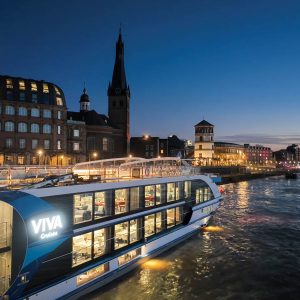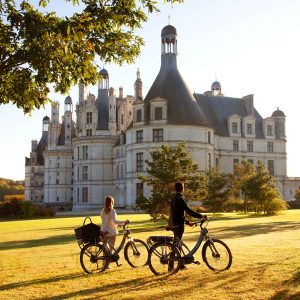It is always a pleasure visiting castles and exploring their bloody and violent past. Castles have played vital, pivotal roles in UK history in times of war and great danger. Many today are in ruins but still worth a visit. It is ironic that today after years of defending against intruders their survival now relies on a daily invasion of, albeit non-violent, tourists.
Here are my personal 10 favourite castles to visit, in no particular order.
Tintagel Castle
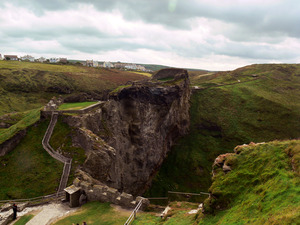
I first visited cliff top Tintagel on a summer day in the late 70s. The site was enveloped in a sea fret. A disappointing start. But as the mist cleared it was easy to see why a castle was built here. With unrivalled views across the Atlantic, Tintagel is atmospheric, wind beaten, wave blasted and truly romantic. Stunning views on a beautiful coastline. This 13th century castle was built by Richard, Earl of Cornwall, on the site of an earlier prehistoric fortress.
Beneath the ruins is Merlin’s Cave, home to the mighty wizard and teacher. Here legends swirl as much as the sea below. Stories about King Arthur and his Round Table Knights never go away. Many scoff but Tintagel claims to be the birthplace of the King. Son of Uther Pendragon and mum (without the M) Igraine. Why let true facts stand in the way of tourist pounds and dollars? An early example of ‘fake news’?
Urquhart Castle
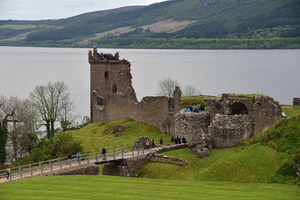
Magnificent ruined Urquhart Castle is a gem. Perched on the banks of Loch Ness at its deepest part. Very picturesque and moody and surrounded on three sides by this monstrous piece of water. The ruins today are from the late 16th century. It was destroyed in the Jacobite Risings in the 17th century but the ruins are still impressive. Urquhart has changed hands many times. It was used as a base for the Macdonald clan. Great views of the loch and fingers crossed, who knows what you may see?
Dover Castle
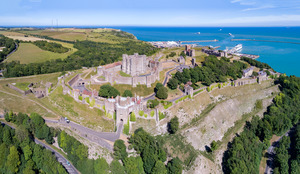 The first and last UK castle travellers see on arrival or departure to these shores. It is located at one of the English Channel’s narrowest points and is forever associated with Vera Lynn and the White Cliffs. Affectionately known as the ‘Key to England’ – England’s first line of defence.
The first and last UK castle travellers see on arrival or departure to these shores. It is located at one of the English Channel’s narrowest points and is forever associated with Vera Lynn and the White Cliffs. Affectionately known as the ‘Key to England’ – England’s first line of defence.
It is one of England’s largest castles. These bricks and mortar have played a pivotal role in Britain’s history. A Roman lighthouse still stands proudly in the grounds. King Henry II asked master builder, unassuming Maurice the Engineer, to design and construct an imposing edifice. He succeeded brilliantly using stones left from the Roman invasion. The Great Tower/Keep is superb- walls up to 21 feet thick and 83 feet tall. A true landmark.
Dover is equally famous for the miles of tunnels dating back to the Middle Ages. In WW2 they became barracks and a HQ for covert military operations. The Allied evacuation on D Day and the Battle of Britain were coordinated from here.
Leeds Castle
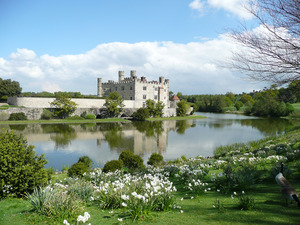 When I was young I always thought this 12th century castle was in my home county of Yorkshire. But no, it is near Maidstone in Kent. Named after the nearby village situated in the Garden of England. The main structure is Norman but bits of Victoriana have been added. Once home to Catherine of Aragon, the first wife of Henry VIII.
When I was young I always thought this 12th century castle was in my home county of Yorkshire. But no, it is near Maidstone in Kent. Named after the nearby village situated in the Garden of England. The main structure is Norman but bits of Victoriana have been added. Once home to Catherine of Aragon, the first wife of Henry VIII.
Black swans glide in the lake and were a gift from Sir Winston Churchill. There are 500 acres of parkland surrounding the castle to explore. The maze has an intriguing underground grotto. Come in spring and you will be charmed by the wood and garden awash with daffodils and narcissi. Is this England’s loveliest castle as many think? Almost!
Corfe Castle
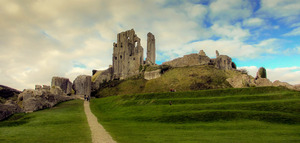 A magical fairy tale castle with over 1000 years of history in its walls. Picturesque, jagged and starkly impressive. It sits proud on a lump of a hill overlooking Corfe village.
A magical fairy tale castle with over 1000 years of history in its walls. Picturesque, jagged and starkly impressive. It sits proud on a lump of a hill overlooking Corfe village.
Originally Saxon and wooden and added to in stone over the years. In the Civil War the castle was attacked by Cromwell who celebrated his victory by dismantling it. Ravens roost and legend proclaims that if they leave then the castle will suffer!
Stirling Castle
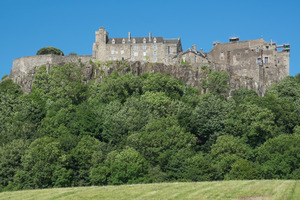 The walk up the hill to the castle is a good cardio workout. Asthmatics may need an extra puff on their inhaler. This castle, a symbol of Scottish tenacity, has it all. A massive impressive fortress on a rocky outcrop dominating its surroundings. A strategic position guarding the route in central Scotland to and from the Lowland to the Highlands.
The walk up the hill to the castle is a good cardio workout. Asthmatics may need an extra puff on their inhaler. This castle, a symbol of Scottish tenacity, has it all. A massive impressive fortress on a rocky outcrop dominating its surroundings. A strategic position guarding the route in central Scotland to and from the Lowland to the Highlands.
Childhood home of Mary Queen of Scots. Bonnie Prince Charlie and brave hearts William Wallace and Robert the Bruce feature heavily in its history.
The Great Hall is Scotland’s biggest and was fully restored in the 20th century. A wonderful day out.
Eilean Donan Castle
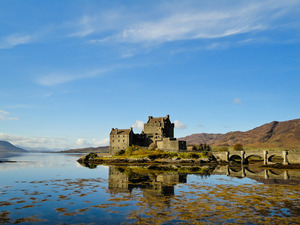 Adorning more tins of biscuits, especially shortbread, than any other British castle. Star of countless cinematic outings too. It has a magical loch-side setting, built on an islet linked by a stone bridge, where three sea lochs meet. HQ of the MacRae clan. Constructed in the 13th century as a Highland stronghold, it was ruined following bombardment by the Royal Navy in 1719. A truly romantic home much restored in the 20th century.
Adorning more tins of biscuits, especially shortbread, than any other British castle. Star of countless cinematic outings too. It has a magical loch-side setting, built on an islet linked by a stone bridge, where three sea lochs meet. HQ of the MacRae clan. Constructed in the 13th century as a Highland stronghold, it was ruined following bombardment by the Royal Navy in 1719. A truly romantic home much restored in the 20th century.
It is not the castle featured in Monty Python and The Holy Grail. No, that is Doune Castle, which is equally impressive, in Stirlingshire. A place to take your coconut shells.
Maiden Castle
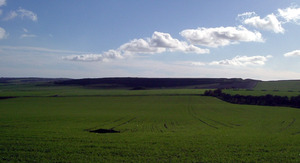 Not a castle in the purest sense. A forerunner of stone fortifications but it deserves mention. The biggest hill fort in Britain covering 47 acres – 50 football pitches. The name comes from the Celtic meaning great hill (MAI DUN). And built to protect those living there.
Not a castle in the purest sense. A forerunner of stone fortifications but it deserves mention. The biggest hill fort in Britain covering 47 acres – 50 football pitches. The name comes from the Celtic meaning great hill (MAI DUN). And built to protect those living there.
Excavations have revealed an Iron Age cemetery and a Roman temple.
Concentric ditches and earth ramparts protect the castle. The gateways through the ramparts were staggered to make attack even more difficult. A great place to notch up those 10,000 steps.
Arundel Castle
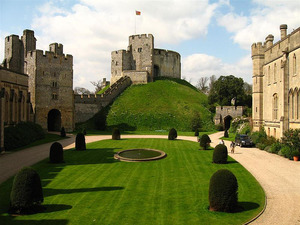 On a still day this castle reflects wonderfully in the River Arun below creating an astonishing visual treat. In a place of great natural beauty overlooking the stunning South Downs.
On a still day this castle reflects wonderfully in the River Arun below creating an astonishing visual treat. In a place of great natural beauty overlooking the stunning South Downs.
Built a few years after the Norman Conquest to defend the valley against attack from the sea. But most of what is seen today is Victorian grand design finished in 1900. It has it all. Rooms stuffed with quality treasures, armour, china, great furniture and art. Timeless elegance and interiors to drool at. The gardens are magnificent with a large fruit filled conservatory and tree lined avenues. It is still home to the Fitzalan-Howards. Many of their ancestors are laid to rest in the Fitzalan chapel. Canaletto anyone? Van Dyck? Horsey Reynolds? They are all here in Arundel.
Bamburgh Castle
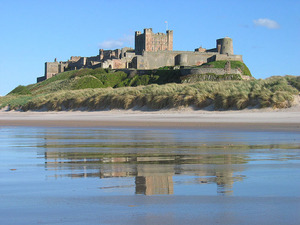 My favourite castle in the UK and in the world! I get goosebumps just saying the name. Sitting majestically, almost magically on the dramatic Northumbrian coast. It stands defiant. Strategically unequalled it looks like a castle should look. I have visited so many times that if I close my eyes I can still see the ups and downs and undulations of this wonderful castle silhouetted against a clear North East sky.
My favourite castle in the UK and in the world! I get goosebumps just saying the name. Sitting majestically, almost magically on the dramatic Northumbrian coast. It stands defiant. Strategically unequalled it looks like a castle should look. I have visited so many times that if I close my eyes I can still see the ups and downs and undulations of this wonderful castle silhouetted against a clear North East sky.
In 547AD it was the seat of Ida the Anglo-Saxon King. Ida’s grandson Ethelfrith gave the stronghold to Bebba, his wife. And from her Bamburgh derives its name Bebbanburgh.
The sight of the castle as you drive over the brow of the hill, on the B1342 (from Budle Bay) and descend into Bamburgh village is stunning and still takes my breath away. One of the finest views in England without any doubt! If you only see one castle in your life then this is the one.


